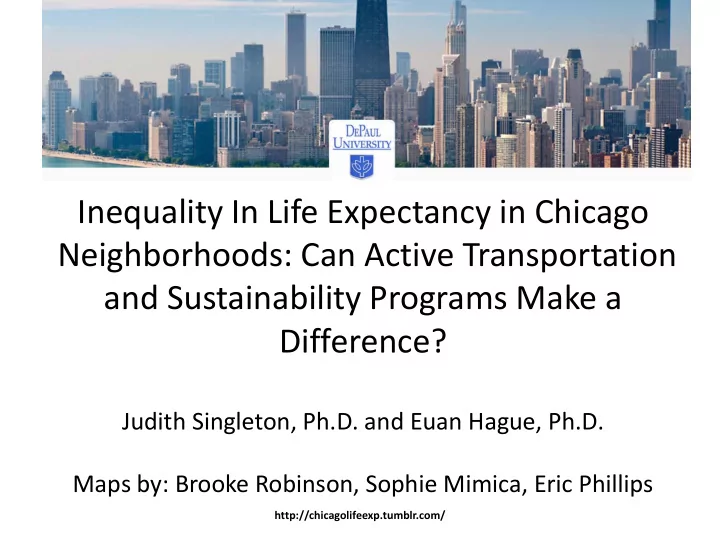

Inequality In Life Expectancy in Chicago Neighborhoods: Can Active Transportation and Sustainability Programs Make a Difference? Judith Singleton, Ph.D. and Euan Hague, Ph.D. Maps by: Brooke Robinson, Sophie Mimica, Eric Phillips http://chicagolifeexp.tumblr.com/
The Inspiration
Life Expectancy Rankings by Nation (2015) … http://chicagolifeexp.tumblr.com/
Life Expectancy Rankings by Nation (2015) … http://chicagolifeexp.tumblr.com/
Life Expectancy in the United States http://chicagolifeexp.tumblr.com/
Social determinants of health Social determinants of health are conditions in the environments in which people are born, live, learn, work, play, worship, and age that affect a wide range of health, functioning, and quality-of-life outcomes and risks. Conditions (e.g., social, economic, and physical) in these various environments and settings (e.g., school, church, workplace, and neighborhood) have been referred to as “ place. ” In addition to the more material attributes of “ place, ” the patterns of social engagement and sense of security and well-being are also affected by where people live. Resources that enhance quality of life can have a significant influence on population health outcomes. Examples of these resources include safe and affordable housing, access to education, public safety, availability of healthy foods, local emergency/health services, and environments free of life-threatening toxins. CDC Healthy People 2020 https://www.healthypeople.gov/2020/topics-objectives/topic/social-determinants- of-health
Healthy Chicago 2.0 • Coordinated by CDPH – Consult 130 organizations • “ Health equity is achieved when every person has the opportunity to attain his or her full health potential ” (CDC) • “ When it comes to health, your zip code matters more than your genetic code. ” Tony Iton, M.D. http://chicagolifeexp.tumblr.com/
Healthy Chicago 2.0 • Utilizes a “health in all policies” perspective. • Understands urban development as critical to improving public health. • “By addressing both traditional health issues such as chronic disease and the root causes of poor health such as transportation and housing , Healthy Chicago 2.0 aims to ensure that every child raised in Chicago, regardless of neighborhood and background, has the resources and opportunities to live a healthy life.” (Rahm Emanuel, Mayor, City of Chicago, emphasis added)
Root Causes • “The built environment influences health by providing or preventing opportunities for physical activity, adequate transportation and social connectedness. Inadequate infrastructure for active transportation exists in many low- income communities and communities of color, which are more likely to have poorly maintained sidewalks and streets and increased dangers from traffic. Fatalities from traffic crashes disproportionately impact African American communities. In addition, street design neglects the needs of older adults, people with disabilities and children.” ( Healthy Chicago 2.0 , p.16) http://chicagolifeexp.tumblr.com/
Healthy Chicago 2.0 • Includes 14 maps – Obesity – Unemployment – Health Insurance – Active Transit Use – Infant Mortality – Asthma http://chicagolifeexp.tumblr.com/
Healthy Chicago 2.0 • Identifies four key areas impacting the social determinants of health: – Built environment – Economic development – Housing – Education
Urban Development • Healthy Chicago 2.0 recognizes health impacts of: – Transit choices and urban development – Perceptions of accessibility and public safety • Goal 1: “Improve Chicago’s built environment and transportation so that residents can live and age well in healthy communities” – 10% increase of adults who walk, bike or take public transportation to work – prioritize pedestrians in the planning, design, operations and maintenance of the built environment – Implement citywide bike plan that includes equity, health and economic development – Improve partnerships between bike share and public health providers
Urban Development • Goal 2: “Realize Chicago’s Vision Zero initiative by eliminating all pedestrian, bicycle and motor vehicle traffic crash fatalities in Chicago” – 118 fatal car crashes in 2014 – Reduce the number of serious injuries resulting from traffic crashes by 10% annually http://chicagolifeexp.tumblr.com/
Healthy Chicago 2.0 – Goals by 2020 • Increase average life expectancy by 2% – From 77.8yrs to 79.4yrs • Expand Divvy Bike share program throughout Chicago (346,000 trips using Divvy during the month of May) • Expand Red Line south to 130 th • Make city-owned vacant land available to current property owners • Encourage and fund development near transit that includes mixed land use
Sustainable Chicago Action Agenda • Increase average daily transit ridership • Accelerate T-O-D around stations • Make Chicago the most bike and pedestrian- friendly US city • Improve freight rail and high speed passenger trains • Strengthen infrastructure to improve fuel efficiency • Advance sustainability at airports http://chicagolifeexp.tumblr.com/
Increase average daily transit ridership • Reconstruct and renew to create “safe, dry and bright” stations • Install network-wide bus and train tracker signs • Buy new buses, add Bus Rapid Transit routes http://chicagolifeexp.tumblr.com/
http://chicagolifeexp.tumblr.com/
Mapping Chicago’s Health http://chicagolifeexp.tumblr.com/
http://chicagolifeexp.tumblr.com/
White Population http://chicagolifeexp.tumblr.com/
http://chicagolifeexp.tumblr.com/
http://chicagolifeexp.tumblr.com/
http://chicagolifeexp.tumblr.com/
http://chicagolifeexp.tumblr.com/
Pilsen and Washington Park • Similar hardship indices • 12 year difference in life expectancy – Pilsen = 81.4 years – Washington Park = 68.9 years • Different economic development profiles – Pilsen: gentrification, real estate – Washington Park: Obama Library, “inclusive development” http://chicagolifeexp.tumblr.com/
Pilsen http://chicagolifeexp.tumblr.com/
Unemployment (2010) http://chicagolifeexp.tumblr.com/
Pilsen http://chicagolifeexp.tumblr.com/
Pilsen http://chicagolifeexp.tumblr.com/
http://chicagolifeexp.tumblr.com/
http://chicagolifeexp.tumblr.com/
The Barack Obama Presidential Center http://chicagolifeexp.tumblr.com/
http://chicagolifeexp.tumblr.com/
http://chicagolifeexp tumblrcom/
Conclusions • Central role of transit and urban development in Healthy Chicago 2.0 plan – Utilizes a “health in all policies” perspective. • Growing importance of GIS/geospatial data for explaining health and urban inequalities • Next step – neighborhood-specific research, including qualitative data and analysis http://chicagolifeexp.tumblr.com/
http://chicagolifeexp.tumblr.com/
Recommend
More recommend